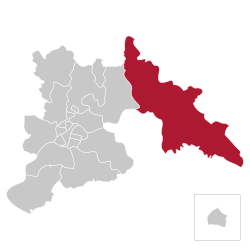Loading AI tools
County in P'yŏngyang-Chikhalsi, North Korea From Wikipedia, the free encyclopedia
Kangdong County is one of Pyongyang's two suburban counties. In 1983 it was separated from South P'yongan Province and assumed direct governance by the Pyongyang City People's Committee. It is bordered by Sŏngch'ŏn-gun (Songchon County), South P'yongan in the north and east, Sŭngho-guyŏk (Sungho District) from the south and the Taedong River from the west.
Kangdong County
강동군 | |
|---|---|
| Korean transcription(s) | |
| • Hanja | 江東郡 |
| • McCune-Reischauer | Kangdong-gun |
| • Revised Romanization | Gangdong-gun |
 Location of Kangdong County within Pyongyang | |
| Coordinates: 39°5′26.99″N 126°8′12.01″E | |
| Country | North Korea |
| Direct-administered city | P'yŏngyang-Chikhalsi |
| Area | |
| • Total | 536.1 km2 (207.0 sq mi) |
| Population (2008[1]) | |
| • Total | 221,539 |
| • Density | 410/km2 (1,100/sq mi) |
Kangdong-gun is best known as the location of the supposed Tomb of King Tangun, the Revolutionary Site at Ponghwa-ri. Kim Jong-un's Kangdong Residence[2] is located near the banks of Taedong River.[3] The northeastern part of the county hosts the offices and facilities of the Second Economic Committee, which is the DPRK's weapons industry. Kyo-hwa-so No. 4 is a large reeducation camp in the south eastern part of Kangdong-gun.[4]
Kangdong County is divided into 1 ŭp (town), 6 rodongjagu (workers' districts) and 16 ri (villages):
|
|
Seamless Wikipedia browsing. On steroids.
Every time you click a link to Wikipedia, Wiktionary or Wikiquote in your browser's search results, it will show the modern Wikiwand interface.
Wikiwand extension is a five stars, simple, with minimum permission required to keep your browsing private, safe and transparent.